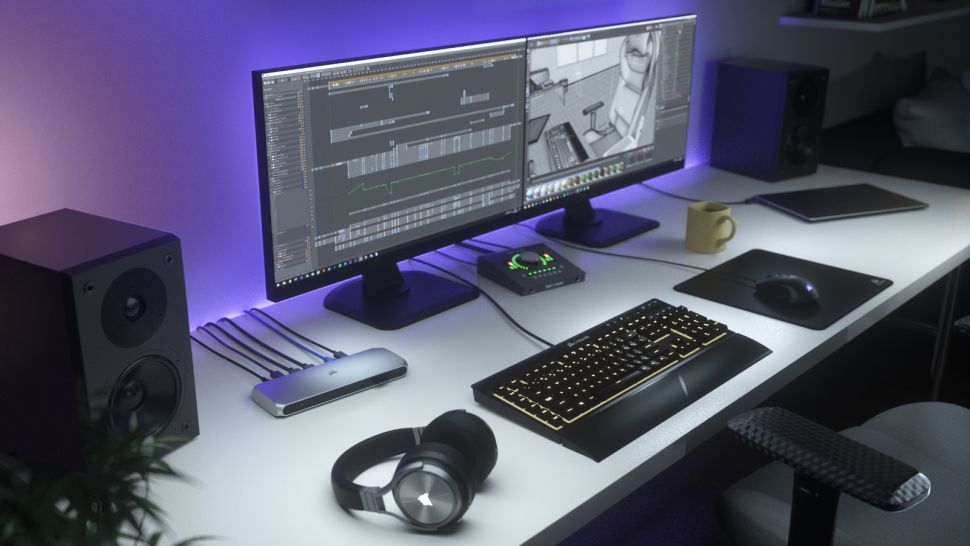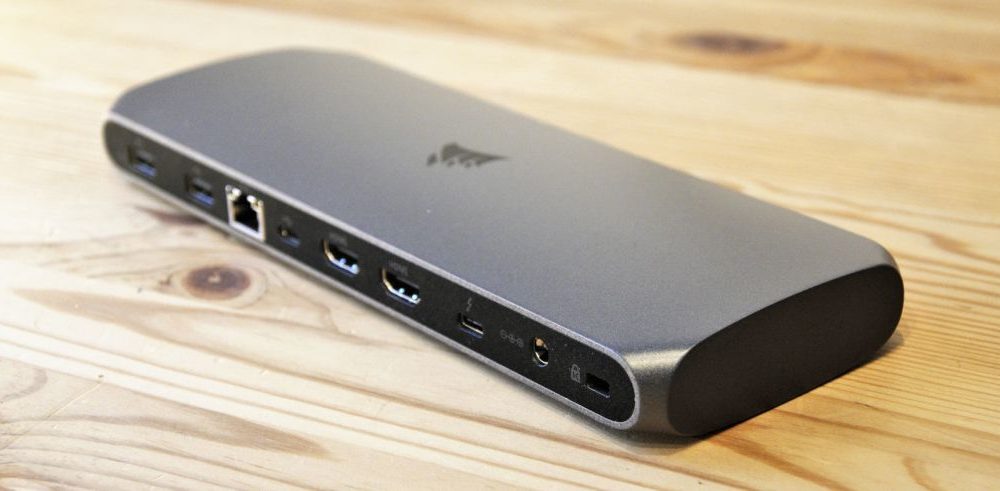OUR VERDICT
For those that don’t need a Thunderbolt downlink, then this could be the perfect single cable dock for your system. It’s well-made, provides a good selection of ports and works out of the box.
FOR
- Elegant styling
- Simple to deploy
- Dual HDMI ports
AGAINST
- Type-C ports might confuse users
- Lacks TB3 downlink
Corsair is a well-respected brand for memory, SSDs, PC cases and cooling, but it has recently widened its scope with new options that includes a line of docking stations.
Those that use a laptop as their primary system, in and out of the office, can readily use a docking station to connect to a keyboard, mouse, monitor and network, all with just a single cable connection.
The price of docking solutions is strongly influenced by the connection technology used, with cheaper devices using USB, and the more capable solutions Thunderbolt 3.
Corsair already sells the Elgato Thunderbolt 3 Pro Dock, but the Corsair branded TBT100 is a new product that brings similar features for a similar cost.
This dock is designed to leverage the full 40 Gbps of Thunderbolt 3 bandwidth to support multiple monitors, peripherals, and networking over a single Type-C cable.
With some excellent products already in the market from Elgato, CalDigit and Belkin, among others, what makes the Corsair TBT100 special?

Price, availability and value
Initially available directly from Corsair, the cost of the TBT100 is $259.99 in the US (exclusive of Tax), £269.90 Inc. VAT in the UK, and €299.90 in Europe, again inclusive of Tax.
For a capable Thunderbolt 3 docking station, that’s at the higher end of the cost scale, being marginally more than the excellent Elgato Thunderbolt 3 Dock £260.99 ($249.99).
And, it’s substantially more than the CalDigit TS3 Plus (£229.95) and the Belkin Thunderbolt 3 Dock Pro (£246).
We should mention that most of these products launched with even higher pricing than the TBT100 and have adjusted to market conditions with more competitive costs since.

Design
There are two schools of thought on the shape of docking stations, putting aside those designs that only fit specific Laptop models.
They come either as vertical towers or horizontal blocks, and the designers at Corsair went with the latter option.
To make it look slightly less like a thin plastic brick, the TBT100 design team introduced a gentle curve across the top, and filleted corners to remove any sharp edges.
The front features a power button, single Type-C Thunderbolt port, SD card reader slot and a 3.5mm headphone/microphone jack, leaving most connectivity on the rear.
That single Type-C port on the front is not the means to connect the computer by Thunderbolt 3. Instead, it is for USB peripherals, like Type-C flash drives or external SSDs.
At the back are two more Type-C ports, one of those being USB, and the other is a Thunderbolt 3 port that will connect the host computer.
Along with that are two Type-A USB 3.2 Gen 1 (5 Mbit) ports, two HDMI 2.0 ports, a Gigabit LAN port, a Kensington lock slot and the power input from the external PSU.
It’s a relatively clean design, and the only issue we can envisage is if users become confused by the Type-C ports, and attempt to connect the dock using the wrong one.
As a device that will usually sit on the desk, the TBT100 is a mostly pleasing visual experience.

Hardware
In many respects, these devices design themselves to a degree since Thunderbolt 3 technology dictates much of what is in them.
All docking stations are an exercise in resource management, and on this dock, the critical resource is data bandwidth.
The connection to the computer is a 40 Gbps pathway, and that can be sliced up in several ways, depending on the users’ needs and priorities.
Each HDMI port can use 10 Gbps to handle 4K at 60Hz video, leaving 20 Gbps between the two 10 Gbps USB Type-C, two 5 Gbps Type-A, the 1Gbit LAN, and the various other items, such as the SD Card reader and audio socket.
As the numerate might have already deducted, 20 Gbps can’t support everything fully, some compromises need to be made, and all Thunderbolt 3 docks with this many ports have the same issue.

But bandwidth isn’t all that the TBT100 offers, it can also send power back down the Thunderbolt 3 port to charge the device at the other end, and has a well-specified PSU to do this.
The maximum power throughput is 85 watts, although up to 30 watts of this can be redirected to USB devices if they require power. Factoring in the power the dock needs to function, and a few other demands, the minimum delivered to the host system is 45 watts. Enough to keep a host system functioning, and charging, except in the most demanding circumstances.
This power profile is remarkably like the Belkin Thunderbolt 3 Dock Pro, CalDigit TS3 Plus and Elgato Thunderbolt 3. They all pass 85 watts (roughly) down to the host system, enabling effective charging of the host system.
Where these other products differ is that some, like the CalDigit TS3 Plus and Elgato Thunderbolt 3 Pro, have Thunderbolt 3 downlink ports, allowing some power to be distributed to other devices in the chain.
That wasn’t a direction Corsair took the TBT100, as it has no Thunderbolt downlink.
In use
As Thunderbolt 3 was always envisaged to be, this is an amazingly simple plug-and-play device that with the one exception of confusable Type-C ports should be a doddle for any user to deploy.
Once you’ve established the line between the computer and the Thunderbolt 3 port and installed the Thunderbolt 3 management app for your system, everything else should neatly fall into place.
The only conceivable way that this could go wrong otherwise is those laptop owners that have a Type-C port that they assume is Thunderbolt 3 but is this port is only USB 3.2.
For them, the TBT100 won’t work however they try to connect it, unfortunately.
It’s also worth pointing out, that while many users might fancy running two 4K displays from their laptop, those running a typical system using an Intel integrated GPU, the lack of performance in their display technology might deliver disappointing performance when given this challenge.
We’d recommend that if you intend to run dual displays from a laptop that it has a discrete video card inbuilt that can deliver the video performance necessary to make that a worthwhile exercise.

Competitors
The competition situation is somewhat confused by the Elgato range that Corsair also sells, being that Elgato is a division of Corsair.
They have the Elgato Thunderbolt 3 Dock, Elgato Thunderbolt 3 Pro Dock and Elgato Thunderbolt 3 Mini Dock.
The Pro costs much more than the TBT100, but it does offer two Thunderbolt 3 ports, enabling one to be used to chain other Thunderbolt 3 peripherals. This downlink is a feature than the Elgato Thunderbolt 3 Dock also offers at less cost than the TBT100, but with only a single DisplayPort video connection.
It’s worth noting that it is possible to subvert the spare Thunderbolt 3 port into another DisplayPort output using a converting cable and achieve the same dual display output as the TBT100.
At just $99, the Elgato Thunderbolt 3 Mini Dock is substantially cheaper, but it only offers a single HDMI, DisplayPort, LAN and one USB 3.1 Gen 1 port.
A more serious competitor is the CalDigit TS3 Plus (£229.95), it has an impressive a selection of ports as the TBT100 offers, but also has extra USB ports and a Thunderbolt 3 downlink. Again, it only has a single DisplayPort video connection, but you can use the downlink to add another screen.
And finally, the Belkin Thunderbolt 3 Dock Pro (£246) has an almost identical port selection to the CalDigit TS3 Plus but comes in a horizontal format rather than a vertical tower. One interesting aspect to the Belkin device is that it will work with a USB connection to the host computer (on some systems), but with half the bandwidth available performance will be dramatically reduced.

Final verdict
There is a balance that is difficult to achieve with dock technology, and the TBT100 ticks most of the boxes for the typical laptop user, but not all of them.
The primary limitation of this hardware is that there are no Thunderbolt 3 downlink ports, making it unsuitable for those with Thunderbolt 3 peripherals, like external RAID storage or SSDs.
If you want to chain Thunderbolt devices from the dock, you need to look elsewhere.
But conversely, if you have connections that need USB and HDMI, the TBT100 is perfectly specified. You don’t need to get special cables to connect dual screens, and using that feature doesn’t compromise other functionality.
It is a well-engineered and designed solution that should give many years of service, although Corsair only offers a two-year warranty.
Other similarly specified products aren’t substantially cheaper, making choosing this more about specifications and branding than other factors.
If this review isn’t a hint, Thunderbolt 3 docks are something of a specification minefield, and we’d recommend that before investing in this, or any other design, that you establish exactly how it will be used. And, if the host system is correctly specified to deliver those objectives.
For many users, the Corsair TBT100 will provide them with the seamless single plug and charge scenario that they want, if they have the correctly specified host system to make this work as they expect.
Source: techradar.com





































